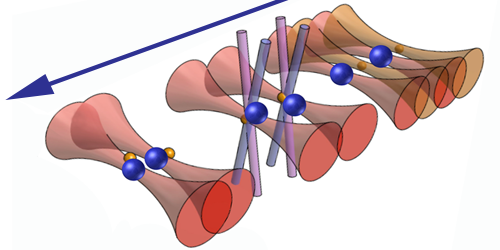Researchers
demonstrated the simplest possible chemical reaction by using optical
tweezers to bring together two atoms to form a molecule.
Y. Liu/Harvard University.
Most
of what we know about chemical reactions comes from experiments that
mix together astronomical numbers of molecules. But while this approach
gives ensemble averages of parameters like reaction rates, it misses
certain details, such as whether the reaction dynamics differ for
different quantum states of the same molecule. Researchers at Harvard
University have now succeeded in stripping a chemical reaction down to
its minimal components. The team built a single molecule from two atoms
that they trapped and brought together with focused laser beams known as
optical tweezers.
“With this scheme, we can control a
chemical reaction at the level of single atoms, without depending on
random encounters between the atoms,” said Lee Liu, a Ph.D. student in
the Harvard group, who presented the result at the American Physical
Society’s meeting of the Division of Atomic, Molecular and Optical Physics (DAMOP). The team, which is led by Kang-Kuen Ni, reported their findings in Science.
The
group’s setup, which they dubbed an ultracold molecular assembler,
allows them to trap laser-cooled atoms and molecules while precisely
controlling the particles’ positions and quantum states. To make their
molecule, the researchers first cooled atoms of sodium (Na) and cesium
(Cs) to below 100 μ
K—a
temperature low enough to manipulate the atoms with optical tweezers.
They then trapped exactly one atom of each species in separate tweezers.
(The tweezers’ wavelengths can be chosen to selectively trap a certain
type of atom.) Crossing the Cs tweezers with the Na tweezers, and
turning off the latter, left exactly one atom of each species in the
roughly micrometer-wide waist of the Cs tweezers. Finally, the team
shined an infrared laser on the two trapped atoms in order to give them
enough energy to form a NaCs molecule—a process known as
photoassociation.
The team confirmed the formation of
the molecule in two ways. First, they monitored the fluorescent light
from the cesium and sodium atoms, which disappeared once the atoms had
bonded together into a molecule. The second piece of evidence was
provided by the detection of characteristic vibrational lines in the
infrared spectrum of the NaCs molecule.
Jun Ye, who
studies cold atoms and molecules at the National Institute of Standards
and Technology and the University of Colorado, both in Boulder,
described the researchers’ approach as unique. “This is the ultimate
level of control of a chemical reaction,” he said. “[It] may allow us to
develop a full quantum-mechanical description of chemical processes.”
Liu
said he is intrigued by these possibilities in fundamental chemistry.
But he raved more about using the method for quantum computing
technologies. “This molecule has the potential to be an exceptional
qubit,” he said. Liu envisions storing information in two of the
molecule’s hyperfine states, which are long-lived and insensitive to
environmental disturbances. This information could then, with the help
of applied microwaves, be transferred to the molecule’s rotational
states. NaCs is a dipolar molecule, and it can strongly interact with
other dipolar molecules. This coupling could be used
to transfer the information stored in an excited rotational state of
NaCs to another molecule in its ground state, providing a way to perform
logical operations.
Liu is eager to get to work
pursuing this molecular qubit idea. He explained that the first
challenge will be finding a way to put the molecule into a single
quantum state. “We think we could soon do it with the help of additional
lasers that coherently transfer the molecule to a specific vibrational
level,” he said.
–Matteo Rini
Matteo Rini is the Deputy Editor of Physics.


